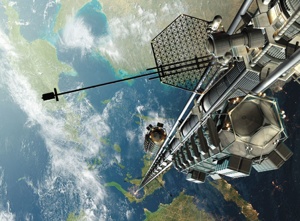Japanese Company Announces Plans for Space Elevator
Nanotube-cable elevator would ferry materials and passengers to a space station in orbit 22,000 miles above the Earth.

"I'm from Iowa. I only work in outer space." — Captain James T. Kirk
Jules Verne would be proud. The technology needed to make it doable is nearly in place. The biggest question remaining: who would pay for it?
A Japanese construction company has announced plans to design and build the world’s first space elevator, which they are hoping to have completed in the next 40 years.
According to the website Rocket News 24, the company, Obayashi Corporation, plans to design an elevator that would transport approximately 30 passengers at a time to a station more than 22,000 miles above the Earth’s service.
The journey will take a little over a week at a speed of 124.27 miles per hour, the Daily Yomiuri Online wrote on Wednesday, and will use a total of 59,000-plus miles of elevator cable constructed from carbon nanotubes, which is reportedly 20 times stronger than steel.
The English-language Japanese newspaper also noted that the terminal station would be home to both a living area and laboratory facilities. While tourists using the elevator would remain there, an AFP report suggests that scientists and researchers could continue on to greater heights.
The company is said to be considering magnetic linear motors as a way to propel the elevator car, while also setting up solar power generators around the terminal in order to transmit power to the ground, Daily Yomiuri reporters added.
Obayashi representatives told AFP that they were inspired by their work on the Tokyo Sky Tree, which will be Japan’s tallest structure at 2,080 feet when work on it is completed in the next few days. However, they also noted that they currently had no idea how much such a project would cost, where they could build it, or who would pay for it.
“Humans have long adored high towers,” project leader Satomi Katsuyama said, according to AFP and the Telegraph. “Rather than building it from the earth, we will construct it from the space… Our experts on construction, climate, wind patterns, design, they say it’s possible.”
“However, we’ll try to make steady progress so that it won’t end just up as simply a dream,” and unnamed Obayashi official added in an interview with the Daily Yomiuri Online.
















